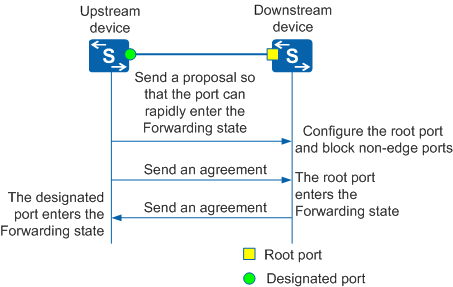MSTP Fast Convergence
Ordinary P/A
Ordinary P/A mechanism supported by MSTP is implemented in the same manner as that supported by RSTP. For details, see Improvements Made in RSTP.
Enhanced P/A
Figure 1 Enhanced P/A mechanism
Enhanced P/A works as follows:
At the beginning of the negotiation, all devices consider themselves as the root bridge, and all ports on the root bridge are designated ports in Discarding state. When the synced variable is set to 1, the Proposal and Agreement fields are set to 1. The upstream device sends a proposal to the downstream device, indicating that the port connecting to the downstream device wants to enter the Forwarding state. After receiving this BPDU, the downstream device sets its port connected to the upstream device as the root port, and blocks all non-edge ports.
The upstream device sends an agreement BPDU. After receiving this BPDU, the root port enters the Forwarding state.
The downstream device replies with an agreement BPDU. After receiving this BPDU, the upstream device sets its port connected to the downstream device as the designated port, and the port enters the Forwarding state.
By default, Huawei switches use fast transition in enhanced P/A. To enable a Huawei switch to communicate with a third-party device that uses fast transition in common P/A, configure the Huawei switch to use ordinary P/A.